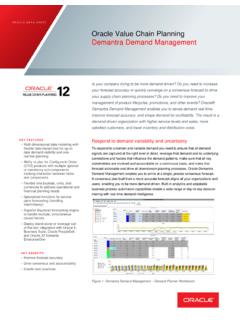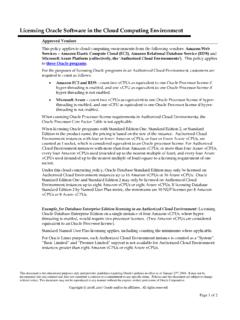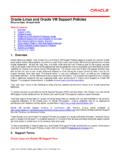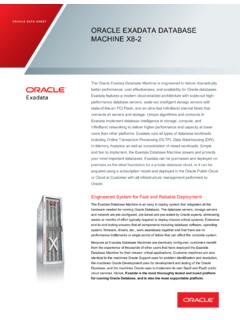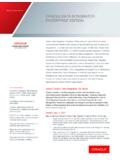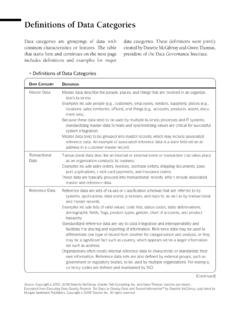Transcription of Oracle (Active) Data Guard 19c
1 Oracle (Active) data Guard 19c Real-Time data Protection and Availability WHITE PAPER/ MARCH 7, 2019 TABLE OF CONTENTS ..3 Oracle Active data Guard An data Guard 19c New How data Guard Synchronizes Standby database (s)..8 Protection Modes ..11 Managing a data Guard Configuration ..11 Using data Guard to reduce Planned Downtime ..13 Active data Appendix A: Summary of (Active) data Guard Features by Version.
2 19 Appendix B: Transient Logical database Rolling WHITE PAPER/ Oracle (Active) data Guard 19c 2 INTRODUCTION Successful high availability (HA) architectures prevent downtime and data loss by using redundant systems and software to eliminate single points of failure. The same principle applies to mission critical databases. Administrator error, data corruption caused by system or software faults, or complete site failures can affect the availability of a database . Even a clustered database running on multiple servers using shared storage can be exposed to single points of failure if not adequately protected.
3 The only way to prevent being impacted by single points of failure is to have a completely independent copy of a production database already running on a different system and ideally deployed at a second location, which can be quickly accessed if the production database becomes unavailable for any reason. Oracle Active data Guard is the most comprehensive solution available to eliminate single points of failure for mission critical Oracle Databases. It prevents data loss and downtime in the simplest and most economical manner by maintaining a synchronized physical replica of a production database at a remote location.
4 If the production database is unavailable for any reason, client connections can quickly, and in some configurations transparently, failover to the synchronized replica to restore service. Active data Guard eliminates the high cost of idle redundancy by allowing reporting applications, ad-hoc queries, and data extracts to be offloaded to read-only copies of the production database . Active data Guard s deep integration with Oracle database and complete focus on real-time data protection and availability avoids compromises found in storage remote mirroring or other host-based replication solutions.
5 This paper describes both Active data Guard (a licensed option) and data Guard (included in Oracle database Enterprise Edition) in detail and is tailored to IT managers, database Administrators and technical staff, who are evaluating different alternatives to protect against data loss and database downtime. WHITE PAPER/ Oracle (Active) data Guard 19c 3 Oracle ACTIVE data Guard AN OVERVIEW Oracle (Active)
6 data Guard capabilities in Oracle database 19c further enhance its strategic objective of preventing data loss, providing high availability, eliminating risk, and increasing return on investment by enabling highly functional active disaster recovery systems that are simple to deploy and manage. It accomplishes this by providing the management, monitoring, and automation software infrastructure to create and maintain one or more synchronized standby databases that protect Oracle data from failures, data corruption, human error, and disasters.
7 Figure 1: Oracle Active data Guard Architecture Overview Active data Guard uses the simplicity of physical replication, but its deep integration with Oracle database provides unique isolation between primary and standby databases to deliver the highest level of protection against data loss. Active data Guard supports both synchronous (guaranteed zero data loss) and asynchronous (near-zero data loss) protection. To maintain high availability for mission critical applications, database administrators can choose either manual or automatic failover to a standby should the primary system become unavailable for any reason.
8 Active data Guard is a licensed option for Oracle database Enterprise Edition. All capabilities described in the following sections that are explicitly referred to as being Active data Guard require an Active data Guard license. All capabilities that are explicitly referred to as data Guard are included with Oracle Enterprise Edition; no option license is required. Active data Guard is a superset of data Guard thus inherits all data Guard capabilities. One of the big advantages of Active data Guard 19c is the better capability to offline read intensive applications to the standby.
9 It is now possible to also issue occasional DML against the standby database , so this is now a fully functional reporting database . This leverages the return on investment as the primary database is used in a more optimal way and the resources of the DR system are used in an optimal way. WHITE PAPER/ Oracle (Active) data Guard 19c 4 data Guard 19C NEW FEATURES ACTIVE data Guard DML REDIRECT This is an Active data Guard OnlyFeature.
10 Which enablesDML operations on thestandby database to be redirected to theprimary database to allow and accommodate for reporting applications that make infrequent writes to actively run on theActive data Guardstandby database . Figure 2: DML Redirect Applying DML on the st andby database can be achievedin 5 simple steps: 1. The user issues DML against the open standby database 2. This DML is redirected to theprimary database 3. The DML is then applied in the primary database 4. The redo information generated the change is streamed back to the standby database 5.

